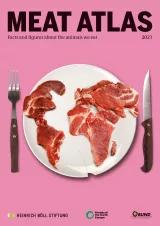
Livestock’s share of global greenhouse gas emissions is understated. The climate footprint of the animals and the feed they need is significant. There are ways to change that.

According to the Food and Agriculture Organization of the United Nations (FAO), livestock was responsible for 14.5 percent of global greenhouse gas emissions in 2013. FAO estimates that 45 percent of livestock-related emissions come from the production and processing of feed, and another 39 percent from enteric fermentation – methane gas produced from the digestive tracts of ruminants such as cattle, sheep and goats. Another 10 percent is attributed to the storage and management of manure.
Taken together, these emissions make up 56 to 58 percent of greenhouse gas emissions from the food sector – even though livestock contribute to only 18 percent of the calories and 37 percent of the protein supply of the world’s human population. According to the Intergovernmental Panel on Climate Change, the food sector accounts for 21 to 37 percent of global greenhouse gas emissions. In 2018, 17 percent of EU emissions stemmed from animal farming.
Livestock account for around 70 percent of all agricultural land. Expansion of livestock production into grasslands for pasture and other ecosystems for growing animal feed has led to land degradation, deforestation and biodiversity loss. About 40 percent of global cropland is used to produce feed. As feed use rises with increased pork and poultry production, land use change has resulted in lost carbon and more greenhouse gases from manufacturing and the use of fertilizers for animal feed. Not just ruminants, but poultry and pigs therefore have contributed to significant emissions in the last two decades.
In 2018, two non-profit organizations – GRAIN and the Institute for Agriculture and Trade Policy – calculated the emissions from 35 of the world’s largest meat and dairy producers. The findings were shocking: just five meat-and-milk giants, JBS, Tyson, Cargill, Dairy Farmers of America und Fonterra, produce more combined emissions per year than major oil players like Exxon, Shell or BP. Taken together, 20 livestock firms are responsible for more greenhouse gas emissions than Germany, Britain or France.
Around 90 percent of the emissions from meat producers come from the supply chain or from the animals themselves. Yet globally, not a single government requires meat producers to document their emissions or standardize their emission reduction targets so as to enable comparisons within the sector. Instead the sector relies on self-reporting. But few companies report their emissions, let alone any targets for reducing them. In 2016, only 3 meat companies had reported some of their emissions from their supply chains (JBS, Marfrig and NH Foods), and only one of these (NH Foods) had given credible figures that matched calculations by the researchers. JBS’s reported emissions were only 3 percent of researchers’ estimates. In 2016, none of the EU meat firms had reported their supply chain emissions.
Solutions proposed for livestock’s climate problem fall into different categories. Meat companies prefer reduced emissions per kilo of meat produced, known as “emissions intensity” reduction. This approach relies on further intensification of production by generating more meat per animal or using less feed per animal without necessarily reducing the number of animals produced. Agriculture science and various NGOs see reducing the production and consumption of animal products as key to climate protection – less and better is the guiding narrative.
A third complementary approach recommended by scientists to cut down production and consumption of food animals is through undertaking measures that reduce competition between food for humans versus feed for animals. For example, biomass unsuited for human consumption, such as crop residues, food scraps and plant parts left over from the processing of crops, can be turned into livestock feed. The researchers estimate that this could produce between 9 and 23 grams of animal protein per person per day – compared to a total demand of 50 to 60 grams a day. They also discovered that such low-cost feeding, combined with the avoidance of competition between feed and food crop production, could lead to 19 to 50 percent fewer greenhouse gas emissions.
In addition, livestock management systems such as “adaptive multi-paddock grazing” have the potential to cut livestock emissions by more than half. In such a system, animals rotate between separate paddocks or grazing areas. This prevents overgrazing, promotes the growth of fodder between the grazing cycles, and imitates the movement of grazing animals in natural systems. This system has been shown to improve pasture productivity, carbon sequestration and fodder quality compared to conventional methods that maintain high numbers of livestock on permanent pastures. Eliminating cereals and replacing them with nitrogen-fixing legumes and a mix of perennial grasses in an integrated livestock management system could also make production more resilient in the face of climate change.


